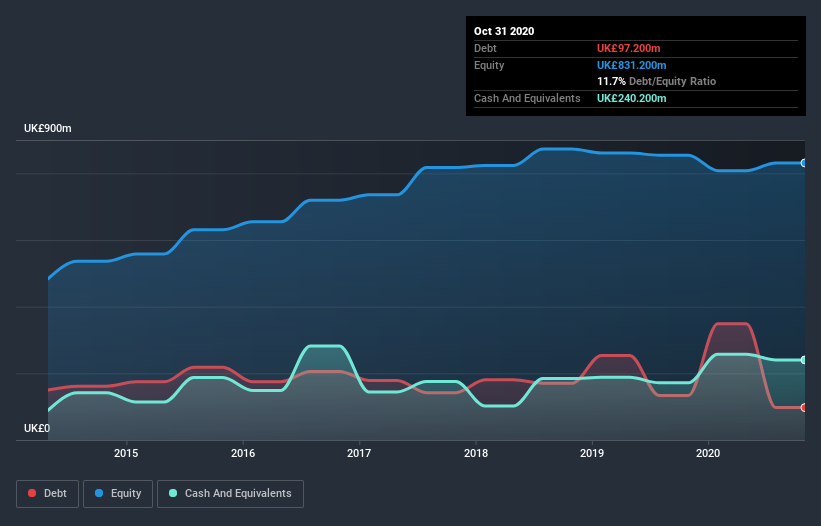These 4 Measures Indicate That Crest Nicholson Holdings (LON:CRST) Is Using Debt Reasonably Well
Warren Buffett famously said, 'Volatility is far from synonymous with risk.' It's only natural to consider a company's balance sheet when you examine how risky it is, since debt is often involved when a business collapses. Importantly, Crest Nicholson Holdings plc (LON:CRST) does carry debt. But the more important question is: how much risk is that debt creating?
What Risk Does Debt Bring?
Generally speaking, debt only becomes a real problem when a company can't easily pay it off, either by raising capital or with its own cash flow. Ultimately, if the company can't fulfill its legal obligations to repay debt, shareholders could walk away with nothing. However, a more common (but still painful) scenario is that it has to raise new equity capital at a low price, thus permanently diluting shareholders. Of course, the upside of debt is that it often represents cheap capital, especially when it replaces dilution in a company with the ability to reinvest at high rates of return. When we think about a company's use of debt, we first look at cash and debt together.
View our latest analysis for Crest Nicholson Holdings
What Is Crest Nicholson Holdings's Debt?
As you can see below, Crest Nicholson Holdings had UK£97.2m of debt at October 2020, down from UK£133.4m a year prior. However, its balance sheet shows it holds UK£240.2m in cash, so it actually has UK£143.0m net cash.
How Strong Is Crest Nicholson Holdings' Balance Sheet?
According to the last reported balance sheet, Crest Nicholson Holdings had liabilities of UK£371.1m due within 12 months, and liabilities of UK£270.8m due beyond 12 months. Offsetting these obligations, it had cash of UK£240.2m as well as receivables valued at UK£96.5m due within 12 months. So its liabilities outweigh the sum of its cash and (near-term) receivables by UK£305.2m.
This deficit isn't so bad because Crest Nicholson Holdings is worth UK£960.2m, and thus could probably raise enough capital to shore up its balance sheet, if the need arose. But it's clear that we should definitely closely examine whether it can manage its debt without dilution. Despite its noteworthy liabilities, Crest Nicholson Holdings boasts net cash, so it's fair to say it does not have a heavy debt load!
Shareholders should be aware that Crest Nicholson Holdings's EBIT was down 58% last year. If that decline continues then paying off debt will be harder than selling foie gras at a vegan convention. When analysing debt levels, the balance sheet is the obvious place to start. But ultimately the future profitability of the business will decide if Crest Nicholson Holdings can strengthen its balance sheet over time. So if you're focused on the future you can check out this free report showing analyst profit forecasts.
But our final consideration is also important, because a company cannot pay debt with paper profits; it needs cold hard cash. Crest Nicholson Holdings may have net cash on the balance sheet, but it is still interesting to look at how well the business converts its earnings before interest and tax (EBIT) to free cash flow, because that will influence both its need for, and its capacity to manage debt. During the last three years, Crest Nicholson Holdings produced sturdy free cash flow equating to 79% of its EBIT, about what we'd expect. This cold hard cash means it can reduce its debt when it wants to.
Summing up
While Crest Nicholson Holdings does have more liabilities than liquid assets, it also has net cash of UK£143.0m. And it impressed us with free cash flow of UK£114m, being 79% of its EBIT. So we are not troubled with Crest Nicholson Holdings's debt use. Of course, we wouldn't say no to the extra confidence that we'd gain if we knew that Crest Nicholson Holdings insiders have been buying shares: if you're on the same wavelength, you can find out if insiders are buying by clicking this link.
At the end of the day, it's often better to focus on companies that are free from net debt. You can access our special list of such companies (all with a track record of profit growth). It's free.
This article by Simply Wall St is general in nature. It does not constitute a recommendation to buy or sell any stock, and does not take account of your objectives, or your financial situation. We aim to bring you long-term focused analysis driven by fundamental data. Note that our analysis may not factor in the latest price-sensitive company announcements or qualitative material. Simply Wall St has no position in any stocks mentioned.
Have feedback on this article? Concerned about the content? Get in touch with us directly. Alternatively, email editorial-team (at) simplywallst.com.

 Yahoo Finance
Yahoo Finance 
